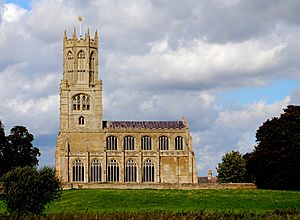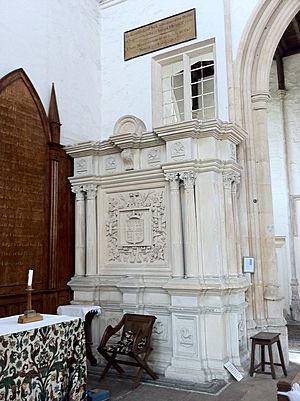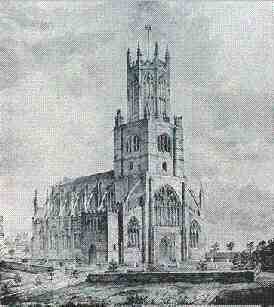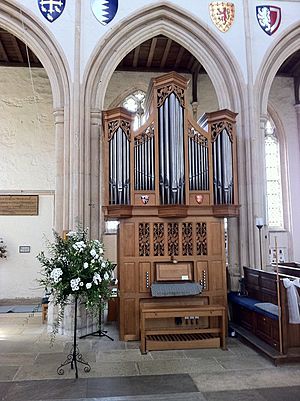Church of St Mary and All Saints, Fotheringhay facts for kids
Quick facts for kids Church of St Mary and All Saints, Fotheringhay |
|
|---|---|

Church of St Mary and All Saints, Fotheringhay
|
|
| 52°31′33″N 0°26′21″W / 52.52586°N 0.43907°W | |
| Country | England |
| Denomination | Church of England |
| Churchmanship | Broad Church |
| History | |
| Dedication | St. Mary and All Saints |
| Architecture | |
| Heritage designation | Grade I listed building |
| Architect(s) | William Horwode |
| Architectural type | Perpendicular Gothic |
| Groundbreaking | 1411 |
| Completed | 1434 |
| Construction cost | £300 (equivalent to £116,466 in 2021) |
| Specifications | |
| Height | 116 feet (35 metres) |
| Administration | |
| Parish | Fotheringhay |
| Deanery | Oundle |
| Archdeaconry | Oakham |
| Diocese | Peterborough |
| Province | Canterbury |
The Church of St Mary and All Saints, Fotheringhay is a historic church in Fotheringhay, Northamptonshire, England. It belongs to the Church of England. This church is famous because it holds a special burial place for important members of the House of York, a royal family involved in the Wars of the Roses.
Contents
Building the Church: A Look at Its History
The construction of this impressive church began way back in 1411. King Edward III started the project, also building a college next to the church. This college was like a school for priests.
Around 1430, the main part of the church was finished. Then, in 1434, a parish church was added to the western side. A local builder named William Horwood was hired by the Duke of York to build the nave (the main part where people sit), the porch, and the tall tower. He was paid £300 for this work. This parish church is the one you can still see today.
The church is dedicated to St Mary and All Saints. It has a very tall, distinctive tower that stands out in the local area. The building style is called Perpendicular Gothic, which means it has tall, slender columns and large windows. Even though only the nave, aisles (side sections), and the octagonal (eight-sided) tower remain from the original grand design, it's still a beautiful example of its time. The tower itself is 78 feet (24 metres) high to its top walls, and 116 feet (35 metres) high if you include the decorative pinnacles.
The famous writer Simon Jenkins once described the church beautifully. He said it looks like a "galleon of Perpendicular on a sea of corn," floating on its hill above the River Nene.
The college next to the church continued until 1547. At that time, the Crown (the government) took control of many religious buildings. The part of the church called the chancel was pulled down soon after. A grammar school was started in its place, which operated until 1859.
Royal Burials: The Yorkist Memorials

Fotheringhay Castle, which was nearby, was an important home for two Dukes of York. One of them, Edward, 2nd Duke of York, was killed in a famous battle called the Battle of Agincourt in 1415. He was buried in this church. He had actually set up the college here earlier. His burial made the church an important burial place for the Yorkist royal family.
In 1476, a very grand ceremony took place here. It was for the re-burial of Richard Plantagenet, 3rd Duke of York (King Edward IV's father) and his younger brother, Edmund, Earl of Rutland. They had both died in the Battle of Wakefield in 1460 and were first buried in a simpler tomb.
King Edward IV wanted to give his father and brother a more honorable burial. Their bodies were brought to Fotheringhay. The King himself was there, showing great respect and sadness. There was a huge procession, with many important people and a funeral chariot pulled by six horses. When the bodies arrived at the church, the King bowed and even kissed his father's body, crying.
Inside the church, special services were held. The Duke of York's armor, shield, and sword were presented. After the funeral, thousands of people came to the church. A huge dinner was served, partly in the castle and partly in the King's tents, with lots of food like capons, swans, and rabbits!
In 1495, Cecily Neville, Duchess of York, who was the wife of the 3rd Duke of York, was also buried next to her husband. She left many valuable items to the college in her will.
Later, during the 1500s, when the choir of the church was destroyed, the original York tombs were damaged. Queen Elizabeth I ordered new monuments to be built for the 3rd Duke and his wife around the altar. These are the memorials you can see today.
Every year, on the birthday of Richard III, the Richard III Society places white roses in the church to remember him.
Special Features of the Church
The Pulpit: A Royal Gift

The church has a special 15th-century pulpit (where the priest gives sermons). It was a gift from King Edward IV. You can see the royal arms on it, along with symbols for his brothers: a bull for George of Clarence and a silver boar for Richard of Gloucester.
The Organ: Music in the Church
The church has a beautiful pipe organ with two keyboards. It was built around the year 2000 by Vincent Woodstock. You can find more details about this organ on the British Institute of Organ Studies National Pipe Organ Register.
Images for kids








